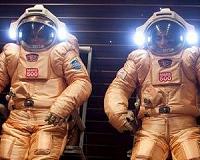 |
Tempe AZ (SPX) Feb 04, 2011 The avalanche faces of huge Martian sand dunes, long thought to be frozen in time on the distant planet, are being re-sculpted on a seasonal basis, according to results of an investigation led by a Planetary Science Institute researcher. The vast northern dunes on Mars - covering an area larger than Texas at 845,000 square kilometers - were believed by planetary scientists to be fairly static, shaped long ago when winds on the planet's surface were much stronger than seen today, said Candice Hansen, a senior scientist at PSI and lead author of a paper titled "Seasonal Erosion and Restoration of Mars' Northern Polar Dunes" that appears in the journal Science this week. New images from the High Resolution Imaging Science Experiment (HiRISE) camera aboard NASA's Mars Reconnaissance Orbiter tell a different story. "Many dunes in the northern polar region of Mars have shown substantial changes in morphology within just one Martian year," said Hansen, who also serves as deputy principal investigator on the HiRISE team. A seasonal layer of frozen carbon dioxide, or dry ice, that blankets the region in winter and sublimates, or changes from solid to gas state, in the spring is responsible for the annual erosion of the polar Martian dunes, Hansen said. "This gas flow destabilizes the sand, causing avalanches and creating new alcoves, gullies and sand aprons on Martian dunes," she said. Comparing images from the HiRISE camera taken over two Mars years - about four Earth years - the team led by Hansen discovered that the dunes they studied at high latitudes showed changes indicating that they are not strongly crusted or ice cemented, as previously assumed by Mars scientists. "The level of erosion in just one Mars year was really astonishing," Hansen said. "In some places hundreds of cubic yards of sand have avalanched down the face of the dunes." The orbiting HiRISE camera obtained a series of images in several northern polar locations so the team could study the seasonal process of ice sublimation. Before and after images were compared in the hopes of detecting subtle changes. To their surprise the team found new deep alcoves scarring the brinks of dunes. Sand avalanching from the top of the dune spread out in aprons extending over the ground beneath the dunes, changing dune boundaries. The changes in dune morphology are correlated with locations of enhanced seasonal activity (as shown in the HiRISE images). Seasonal activity shows up as dark particles ejected out from under the seasonal ice layer, which then settle out on top of the bright ice. "Melting H2O snow and ice are known to cause sand avalanches and flows on Earth's Antarctic dunes, but it would seem that the erosive action of carbon dioxide ice sublimation is unique to sand dunes on Mars," said Mary Bourke, PSI senior scientist and co-author. Especially surprising was the discovery that scars of past sand avalanches could be partially erased in just one Mars year by the movement of small ripples. Models of Mars' atmosphere do not predict wind speeds adequate to lift sand grains, and data from Mars landers at lower latitudes show high winds are a rare occurrence. "Perhaps polar weather is more conducive to high wind speeds," Hansen said. HiRISE has an ongoing campaign to re-image dunes at all latitudes to understand winds in the current climate on Mars, Hansen said. The research was funded by a Mars Reconnaissance Orbiter program grant from NASA. "Understanding how Mars is changing today is a key first step to understanding basic planetary processes and how Mars' climate changes over time," said Alfred McEwen, HiRISE principal investigator and paper co-author.
Share This Article With Planet Earth
Related Links Planetary Science Institute Mars News and Information at MarsDaily.com Lunar Dreams and more
 Mars500 Arrives In Orbit Around Mars
Mars500 Arrives In Orbit Around MarsParis, France (ESA) Feb 03, 2011 The first full-duration simulation of a manned voyage to Mars has reached a major milestone: the 'spacecraft' yesterday 'arrived' at Mars after 244 days of virtual interplanetary flight. Three crewmembers will 'land' on Mars on 12 February and make three sorties onto simulated martian terrain. Mars500, a pioneering international study of the complex psychological and technical issues that ... read more |
|
| The content herein, unless otherwise known to be public domain, are Copyright 1995-2010 - SpaceDaily. AFP and UPI Wire Stories are copyright Agence France-Presse and United Press International. ESA Portal Reports are copyright European Space Agency. All NASA sourced material is public domain. Additional copyrights may apply in whole or part to other bona fide parties. Advertising does not imply endorsement,agreement or approval of any opinions, statements or information provided by SpaceDaily on any Web page published or hosted by SpaceDaily. Privacy Statement |